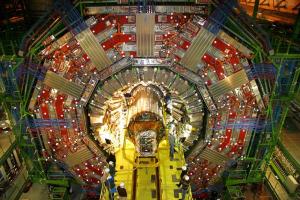CMS is designed to see a wide range of particles and phenomena
produced in high-energy collisions in the LHC. Like a cylindrical onion,
different layers of detector stop and measure the different particles,
and use this key data to build up a picture of events at the heart of
the collision.
Scientists then use this data to search for new phenomena that will
help to answer questions such as: What is the Universe really made of
and what forces act within it? And what gives everything substance? CMS
will also measure the properties of previously discovered particles with
unprecedented precision, and be on the lookout for completely new,
unpredicted phenomena.
With an international structure, more than three thousand physicists
and engineers work in CMS, IFCA's contribution has been centered in the
development and construction of an alignment system for the muon
chambers of the detector. We have also participated in the development
of a Tier-2 facility to analyze the huge amount of data produced during
collisions, by means of GRID applications. The Physics channels in which
our group work are: Higgs, SUSY, stop and Dark Matter, preferably with two isolated
leptons in their final state. Recently we also work in the pixel upgrade for Phase2 in CMS that will start taking data in 2026. Members of our team are activily working on 3D pixel which will resist more radiation that the planar ones.
Our involvement in responsability posts start with Prof. Teresa
Rodrigo which was the chairperson of the collaboration Board of
the CMS experiment. Furthemore, Dr. Celso Martínez Rivero, Dr. Luca Scodellaro, Dr. Gervasio Gómez and Dr. Iván Vila are the people responsible for the actual national projects of CMS while
Prof. Francisco Matorras is the person in charge of our Tier-2 facility
in the LHC Grid Computing.

